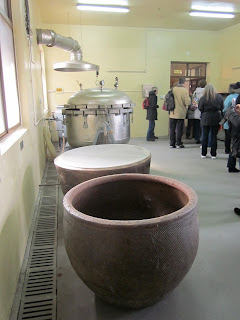This isn't what you expected, is it? Sorry to disappoint. I tell you,
I wasn't disappointed by this tour given by the Shanghai Expat Association (SEA).
As is tradition, here is the SEA blurb:
Day Trip: Handmade Heritage Soy Sauce
Red cooking or hongshao is the word for Shanghai cuisine. For centuries, the city's culinary culture has been stewed, simmered, sautéed and braised in soy sauce. We are proud to say this will be the only tour in China that takes you to a hand-crafted soy sauce factory which has a history of over 130 years. It is believed to be one of few in the world that still make soy sauce the traditional, old-fashioned way. We will meet the soy sauce master who has been making soy sauce for nearly 30 years. In fact, the way he makes soy sauce hasn't changed since the days of his forefathers. Their soy sauce making process was listed as one of China's Intangible Cultural Heritages - the only one in the industry.
Before we walked around the factory, we had a movie and a lecture on how soy sauce is made and the differences between Qian Wanlong soy sauce and mass produced soy sauce. Nowhere near as bad as learning how hot dogs are made, but I am only buying Qian Wanlong soy sauce from now on. No, I'm not the new company spokeswoman.
Janny Chyn was our fearless tour leader.
Here she is pointing out the competitors' ingredients.
How do you spell MSG?
Time to compare and contrast
Bottoms up!
We could actually discern the differences between the two brands.
Out we went to the factory.
These will be explained all in due time. Just enjoy the view for now.
First, more history.
These were some company artifacts that survived the Cultural Revolution.
This wooden plaque was given to the Qian Wanlong company 130 years ago when they were recognized as official soy sauce supplier to the Emperor. That was a fortunate thing because if a company didn't have a government connection, it was difficult to assure a supply of salt to make the salt water essential to soy sauce production.
The plaque survived because a company carpenter recognized its intrinsic value, brought it home and hid it. He had caught wind of the impending
destruction re-education and didn't want to see the plaque
harmed ehhhmm...
ruined ahhhh.... changed, yeah, that's it, changed. Today, this is the only remaining imperial plaque given to a soy sauce manufacturer.
Copies of utensils used in soy sauce production
Old shoes or a reasonable facsimile
Now on to how the soy sauce is made.
Thank you, Janny, for explaining because my Mandarin is nowhere near
good enough to understand the company guide.
Bags of wheat flour used in the process.
Bags o' soy beans
These are
non-GMO variety from a certain province in northwest China known for its consistently good soy bean production. Don't ask me which province, you know I can't remember. I could make it up and you'd never know...
A tub for mixing the beans with salt water and the mould that kick starts the fermentation
After all the ingredients are mixed, the tubs are taken outside (yes, outside)
where they are left to ferment for an entire year.
I'm glad they were covered!
Now let's take a closer look...
(Cue suspenseful shark approaching type music)
Dah na...
... dah na...
Ewwww! Yes, fermenting soy beans do look like you-know-what.
When the year is over, and the retching stops, the bean and
mould mixture is taken inside and pressed.
The remaining paste becomes pig food and the soy sauce goes back into tubs
and outdoors again for a year's worth of aging.
The master taster took a dip.
Uh, yeah, can I have my sauce from a different tub?
Tucking in the tubs all cozy to finish their year of aging.
See you next year in a bottle, soy sauce!



















































